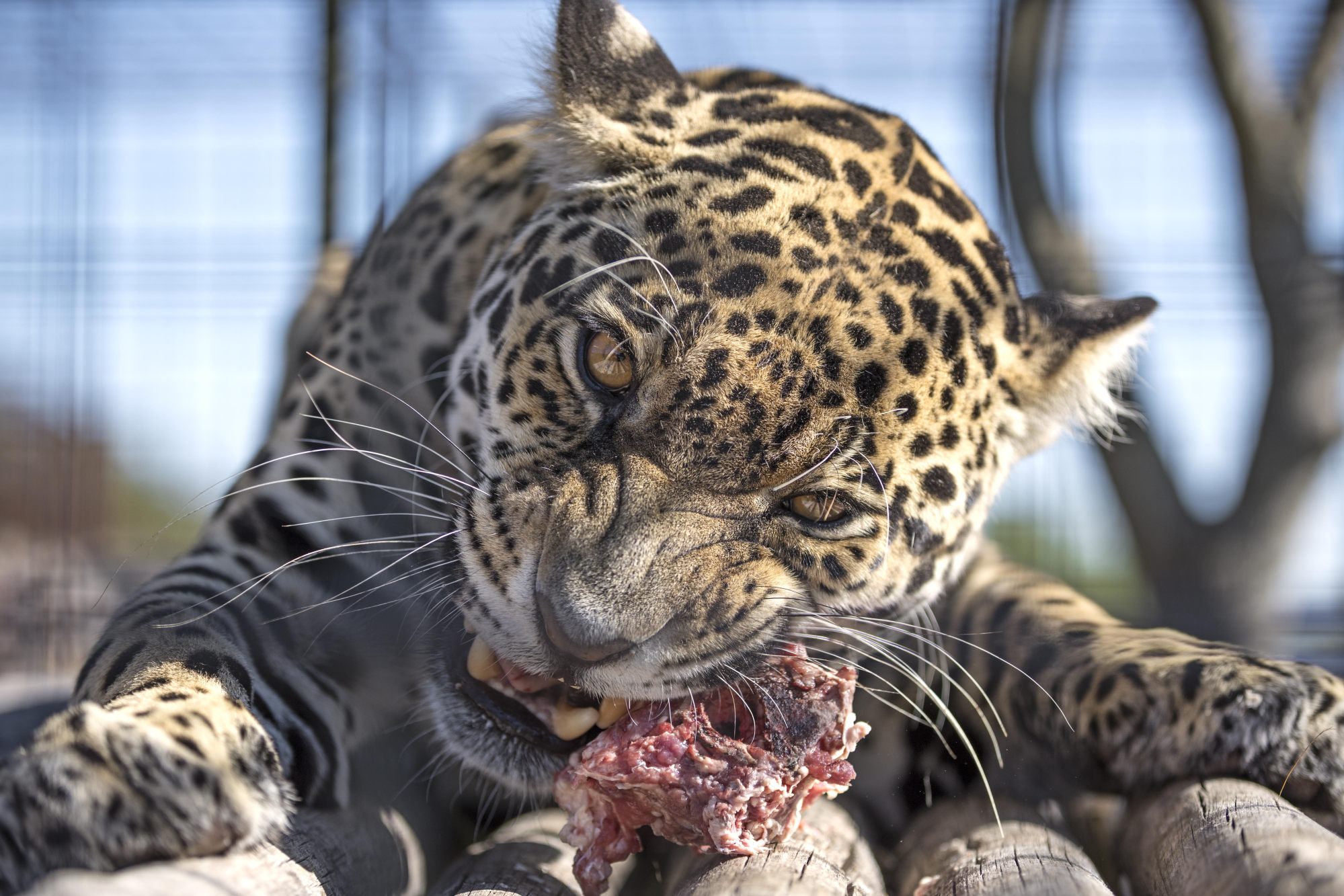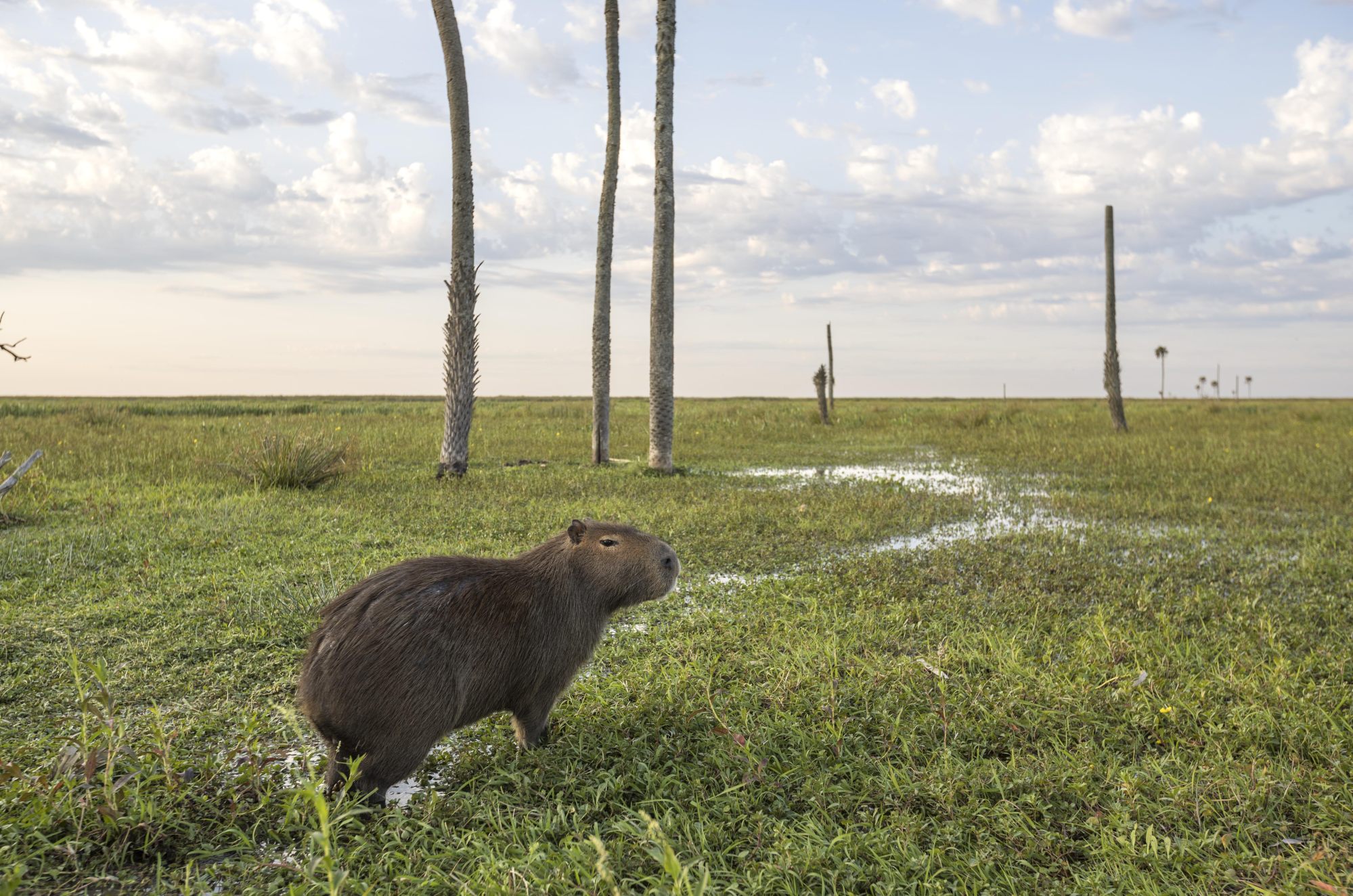
Apex predators, their prey, and myriad bird species – rewilding of wetlands in Argentina, best seen on a horseback safari, makes them a top tourist draw
- Extinct for 70 years, jaguar big cats are back in the Iberá Wetlands, along with macaws and giant otters, thanks to the vision of a conservation-minded couple
- Apparel firm bosses Kristine and the late Doug Tompkins began buying up farmland and restoring Iberá’s breathtaking biodiversity. Now it’s a top tourist draw
It takes an early evening flight low over the Iberá Wetlands to fully appreciate their scale and splendour. With the sun hugging the horizon, the golden-hued lagoons and creeks of this boundless watery labyrinth glint and sparkle, as the last flocks of egret and ibis return home to roost in the marshes below.
30 years ago there were hardly any large wild animals at all
In the language of the Guaraní, an indigenous people living mostly in Paraguay and northern Argentina, iberá means “brilliant waters”. It would be hard to come up with a more fitting description.
From apex predators such as jaguars, pumas and caiman, to omnivores and herbivores such as capybara, marsh deer and giant anteaters – not to mention more than 350 species of birds – the Esteros del Iberá are filled with a dazzling abundance of nature. Today, this is a place for lovers of wildlife, wild places and safari-style exploration.

Yet despite its breathtaking biodiversity, Iberá was little known outside Argentina until recently, while even Argentinians hardly tripped over themselves to pay a visit.
The wetlands were better known as a place for cattle ranching, commercial forestry and hunting – activities that took their toll on many important wildlife species. Iconic animals such as the jaguar, giant otter and red-and-green macaw all disappeared from the wetlands during the 20th century.
“In the past, most people viewed Iberá as a big black hole in the middle of Corrientes,” says Sofia Heinonen, a biologist from Buenos Aires. “The places with lots of water were seen as unproductive wasteland, because you couldn’t raise cows or grow trees there.
“I went on several survey flights over the wetlands 30 years ago – pretty much all you could see were lots of estancias [cattle ranches] and lot of cows. There were hardly any large wild animals at all.”
Today, Heinonen is the executive director of Fundación Rewilding Argentina (FRA). Founded in 2010, this pioneering NGO manages Great Iberá Park, as well as a burgeoning portfolio of other rewilding initiatives in Argentina – from the Amazon-like El Impenetrable National Park, in the Gran Chaco region of northern Argentina (northwest of the Iberá Wetlands), to the high-plateau Parque Patagonia, more than 1,600km to the south.

Heinonen was accompanied on her early survey flights over Iberá by Doug and Kristine Tompkins – a co-founder of The North Face (outdoor recreation products) and former CEO of the Patagonia apparel company, respectively.
The husband-and-wife team had sold up and decamped to South America from the United States in the 1990s, engaging in large-scale conservation through Tompkins Conservation, their non-profit organisation (FRA was spun off from Tompkins Conservation, which continues to collaborate and support rewilding efforts in Argentina). Captivated by Iberá, they began buying land.
“In the early stages, the idea was to simply consolidate territory and protect the landscape,” explains Kristine Tompkins. “But then we found so much wildlife in Iberá was missing – that keystone species such as the jaguar, giant otter and red-and-green macaw had been extinct here for many decades.

“We understood the importance of these species and their role in maintaining healthy, balanced nature and took the decision to embark on a rewilding journey.”
On San Alonso Island, in the heart of the Iberá Wetlands, Malú – a five-year-old female jaguar from Uruguay – paws a large bone.
Applying the full force of her jaws, she shatters it with an emphatic crack. It’s obvious why these stunning big cats sit at the very top of the food chain – and why they have become an icon for Iberá’s rewilding programme.

“Nobody had attempted jaguar reintroduction before, so we were breaking new ground all the way,” explains FRA’s conservation director, Sebastián Di Martino. “It took millions of dollars just to build the huge pre-release enclosures where the animals are now prepared for their long journey into the wild. Then there were all the bureaucratic hurdles involved in bringing together captive jaguars from zoos and rescue centres from across South America. It was a gargantuan undertaking.”
On January 6, 2021, conservationists on San Alonso finally opened up a pen that held two four-month-old jaguar cubs, Karai and Porã, and their mother, Mariua – who had been brought from Brazil – giving them access to the entire Great Iberá Park. It was the first time that jaguars had roamed free in the wetlands for 70 years. It was a headline-grabbing milestone for Iberá rewilding.

Following further releases by FRA, the wild jaguar population stands at 12, with four cubs now born outside captivity. With pumas staging a natural comeback, the ever-increasing number of carnivores roaming the wetlands will help to control the capybara population and restore ecological balance.
Other important species such as ocelot and giant otter, which are being kept in pre-release enclosures at various sites across Iberá, will soon join them.
Also released into the wetlands, Iberá’s wild red-and-green macaw population is growing, with increasing numbers of birds starting to breed and raise chicks.

As Iberá returns to health, its reputation as a unique place to see South American wildlife is blossoming. More than 50,000 tourists visited Great Iberá Park in 2021, while an article in The New York Times in 2022 ranked Iberá sixth out of the 52 best places to visit “for a changed world”.
To ensure local people benefit from the growth in tourism, the FRA has invested heavily in developing park infrastructure, such as access gates, roads, trails, huts, campsites and signage, as well as educational, training and other outreach programmes.
As tourism grows, ever more locals are becoming involved in Iberá’s rapidly evolving regenerative economy.

“Reintroducing animals back into Iberá would have been pointless if the original drivers of their disappearance had still been in effect,” says Marisi López, FRA’s parks and communities coordinator.
“We had to shift the local economy away from farming, timber and hunting and develop nature-based tourism as a way for local people to derive value from the park.
“We had to change people’s mindsets and show them that live animals were way more valuable than dead ones.”

Nature guide Domingo (“Mingo”) Rene Gonzalez exemplifies Iberá’s economic transition. As a former gaucho (cowboy) and hunter, he began offering horse rides through the wetlands about 15 years ago, and now works closely with FRA.
“In the past, people thought of wild animals as a nuisance or a danger, as a resource to be used up until it was gone. But our understanding is better these days.
“More and more people in and around Iberá rely on nature for their jobs and their income, so of course they want to protect it and enhance it.
“The return of nature has put Iberá on the map, and we want to keep it that way.”

